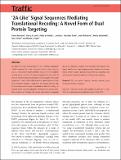"2A-like" signal sequences mediating translational recoding : a novel form of dual protein targeting
Abstract
We report the initial characterisation of an N-terminal oligopeptide ‘2A-like’ sequence that is able to function both as a signal sequence and as a translational recoding element. Due to this translational recoding activity, two forms of nascent polypeptide are synthesised: (i) when 2A-mediated translational recoding has not occurred: the nascent polypeptide is fused to the 2A-like N-terminal signal sequence and the fusion translation product is targeted to the exocytic pathway, and, (ii) a translation product where 2A-mediated translational recoding has occurred: the 2A-like signal sequence is synthesised as a separate translation product and, therefore, the nascent (downstream) polypeptide lacks the 2A-like signal sequence and is localised to the cytoplasm. This type of dual-functional signal sequence results, therefore, in the partitioning of the translation products between the two sub-cellular sites and represents a newly described form of dual protein targeting.
Citation
Roulston , C , Luke , G A , de Felipe , P , Ruan , L , Cope , J , Nicholson , J , Sukhodub , A , Tilsner , J & Ryan , M D 2016 , ' "2A-like" signal sequences mediating translational recoding : a novel form of dual protein targeting ' , Traffic , vol. 17 , no. 8 , pp. 923-939 . https://doi.org/10.1111/tra.12411
Publication
Traffic
Status
Peer reviewed
ISSN
1398-9219Type
Journal article
Description
The authors gratefully acknowledge the support of the UK Biotechnology and Biological Sciences Research Council (BBSRC) who funded this research. The authors also gratefully acknowledge the support of the Wellcome Trust for the provision of mass spectrometry facilities at St Andrews.Collections
Items in the St Andrews Research Repository are protected by copyright, with all rights reserved, unless otherwise indicated.

